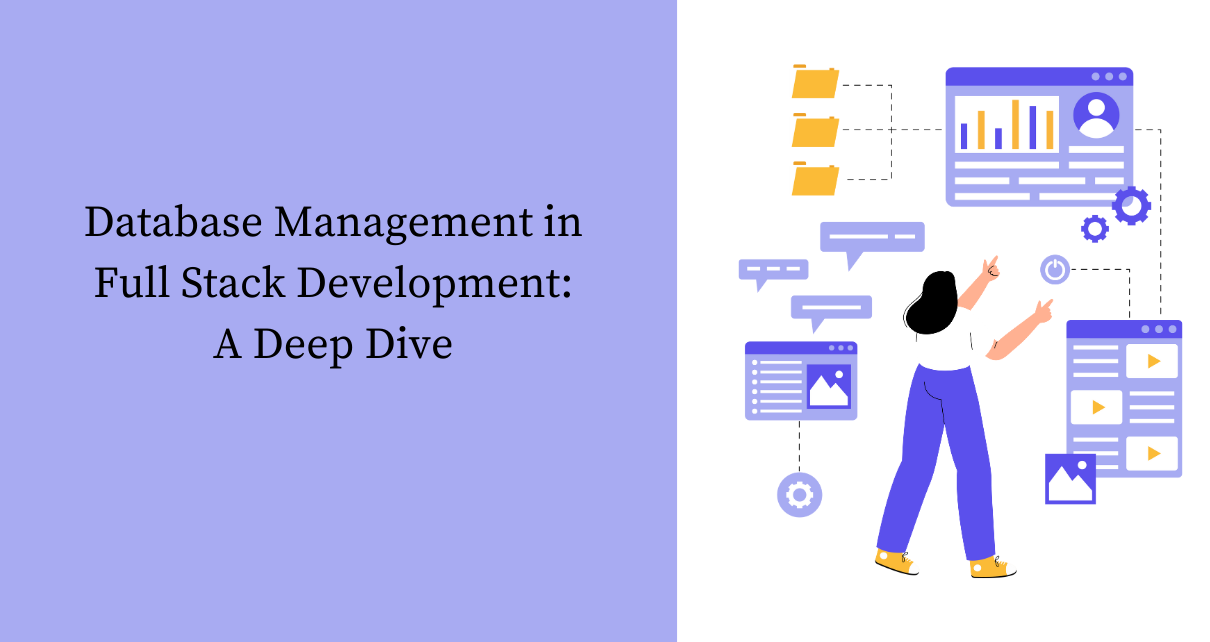Full Stack Development is an all-inclusive method of web development that entails interacting with an application’s front end and back end. Effective database administration is the cornerstone of this development approach. Databases are an essential component of full-stack development because of their critical role in data management, retrieval, and storage. We will examine the importance of database administration in full-stack development, popular database types, and efficient database management techniques in this in-depth analysis.
Importance of Database Management in Full Stack Development
1. Data Storage and Retrieval:
Databases are the foundation of full-stack development’s data storage and retrieval systems. They offer an organized method for storing and organizing data, making it easy for developers to access and work with it. Any web application’s ability to manage data effectively is essential to its success.
2. Scalability:
The amount of data that web applications can process grows with them. Scalability is the ability of the application to accommodate an increasing number of users and data without sacrificing speed; it is dependent on effective database management. Databases with good design are scalable, both vertically and horizontally, to accommodate growing applications.
3. Data Integrity:
For a web application to be reliable, data integrity must be maintained. In order to guarantee that the data stored in the database is correct and consistent, database management systems (DBMS) apply data integrity restrictions, such as unique keys, foreign keys, and data types. This is essential for avoiding mistakes and guaranteeing the application’s dependability.
4. Security:
A primary concern in web development is security. Managing databases requires putting security measures in place to keep private information safe from unauthorized access. This covers frequent security assessments, access limitations, and encryption. A strong database management system makes a big difference in a full-stack application’s overall security posture.
5. Performance Optimization:
Database performance is essential to an application’s responsiveness. Optimizing queries, indexing, and caching are all part of effective database management. Database design and structure are critical skills for full-stack developers to possess to achieve optimal performance and provide a seamless user experience.
Types of Databases in Full Stack Development
Databases come in a variety of forms, each with unique applications and advantages. Based on the needs of the application, full-stack developers must select the right kind of database. The following are a few typical database kinds used in full-stack development:
1. Relational Databases:
Relational databases employ an organized schema with tables and relationships between them, like MySQL, PostgreSQL, and SQLite. They are appropriate for use in applications like financial ones, content management systems, and e-commerce platforms where relationships and data integrity are critical.
2. NoSQL Databases:
In contrast to traditional databases, NoSQL databases—such as MongoDB, Cassandra, and Redis—offer a more flexible data model. They are well-liked for real-time applications, large data, and content streaming systems because they work well with dynamic and developing data structures.
3. In-Memory Databases:
Redis and Memcached are examples of in-memory databases that store data in RAM rather than on a conventional disk. This leads to quicker data retrieval and is appropriate for real-time analytics and caching systems, among other applications that need low-latency access to frequently accessed data.
4. Graph Databases:
Relationships between entities are intended to be represented and stored in graph databases, such as Neo4j. They are perfect for apps like social networks, recommendation engines, and network analysis tools that mostly depend on intricate interactions.
5. Document Databases:
Data is stored as flexible documents that resemble JSON in document databases like MongoDB. Applications with semi-structured or unstructured data, such as document repositories, blogging platforms, and content management systems, are a good fit for them.
Best Practices for Database Management in Full Stack Development
Following best practices is necessary for efficient database management in order to guarantee the application’s maximum performance, scalability, and maintainability. The following are some recommended methods for full-stack developers to manage databases:
1. Normalization:
The practice of structuring data in a database to minimize redundancy and enhance data integrity is known as normalization. Full-stack developers need to comprehend the fundamentals of normalization and construct databases with suitable levels of normalization to the needs of the application.
2. Indexing:
Improving query performance requires proper indexing. It is recommended that full-stack developers locate and generate indexes on frequently used columns in queries. However over-indexing might result in overhead, so it’s critical to find a happy medium and periodically review and improve indexes.
3. Caching:
Because caching reduces the need for repetitive queries, it can greatly enhance database speed. To decrease latency and speed up response times, full-stack developers should make use of caching technologies like Redis or Memcached to keep frequently visited data in memory.
4. Backup and Recovery:
Maintaining regular backups is crucial to preventing data loss in the event of catastrophes or system breakdowns. To guarantee data recoverability, full-stack developers should put automatic backup techniques into place and evaluate the restoration procedure regularly.
5. Security Measures:
Protecting sensitive data requires the use of strong security measures. To mitigate such risks, full-stack developers should encrypt critical data, enforce authentication and authorization procedures, and routinely audit and update security processes.
6. Database Monitoring:
It is essential to continuously monitor database performance in order to spot problems early and take proactive measures to fix them. Monitoring tools should be used by full-stack engineers to keep an eye on important metrics like resource utilization, query execution times, and system health and to react quickly to any abnormalities.
7. Transaction Management:
To ensure data consistency, full-stack developers should be aware of the fundamentals of transactions and apply them correctly. Transactions guarantee that a sequence of database operations either succeeds or, in the event of an error, leaves the database consistent.
8. Scalability Planning:
Effective database administration requires preparing for the application’s potential development in the future. Databases should be designed with scalability in mind by full-stack developers, who should take into account strategies like partitioning, sharding, and replication to manage growing loads.
9. Optimizing Queries:
Optimizing queries is essential for optimal database performance. In order to minimize the strain on the database, full-stack developers should evaluate and optimize queries by employing suitable indexing, avoiding pointless joins, and getting only the columns that are required.
Challenges in Database Management
Even though efficient database administration is crucial, full-stack developers frequently have difficulties making sure databases run smoothly. Typical difficulties include the following:
1. Concurrency Control:
Controlling several users’ access to the database at once can prevent problems like deadlocks and race situations. To avoid data inconsistencies, full-stack developers must use the proper concurrency control strategies, such as locking or optimistic concurrency management.
2. Data Migration:
Changes to the database schema may be required as applications develop. To guarantee a seamless transition free from data loss or downtime, full-stack developers must meticulously design and carry out data migration procedures.
3. Performance Tuning:
Database speed optimization is a continuous effort. Full-stack developers must keep an eye on the database and adjust it as needed to fix bottlenecks, improve query performance, and adjust to shifting usage trends.
4. Security Threats:
Risks to databases from security issues like SQL injection and unauthorized access are substantial. To preserve the integrity of the data, full-stack engineers must periodically audit and fix vulnerabilities and stay current on security best practices.
5. Backup and Recovery Challenges:
Although backups are essential, it might be difficult to guarantee a prompt and dependable recovery in the event of a breakdown. Full-stack developers must conduct routine testing of backup and recovery protocols to ensure data availability when needed.
Conclusion
To sum up, database administration plays a crucial role in full-stack development and affects the security, scalability, and performance of web apps. To ensure effective data management, retrieval, and storage, full-stack developers must follow best practices and possess a solid understanding of various database formats.
You can opt for Full Stack Web Development Course in Noida, Delhi, Chennai, Pune and other parts of India. In the dynamic world of web development, developers can make a positive impact on the overall performance and dependability of full-stack apps by proactively deploying database management strategies and resolving obstacles.




